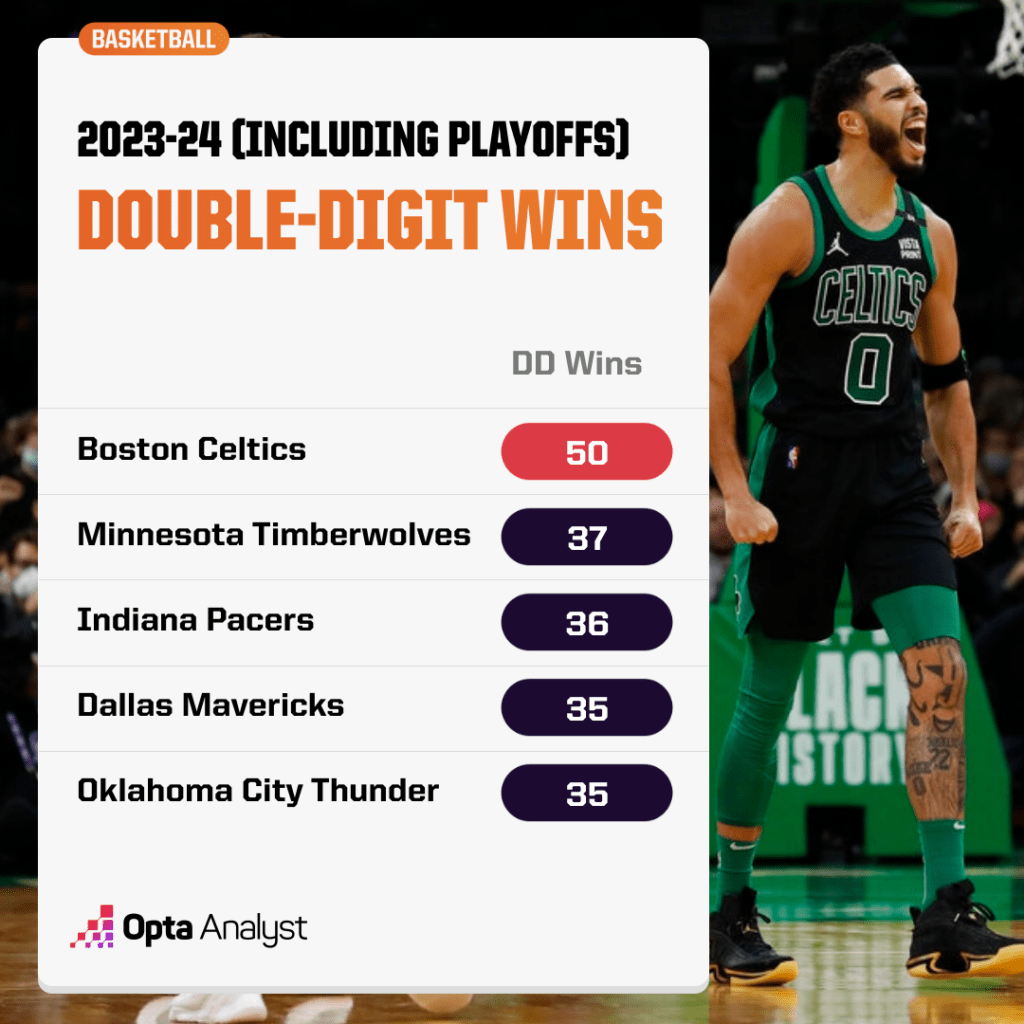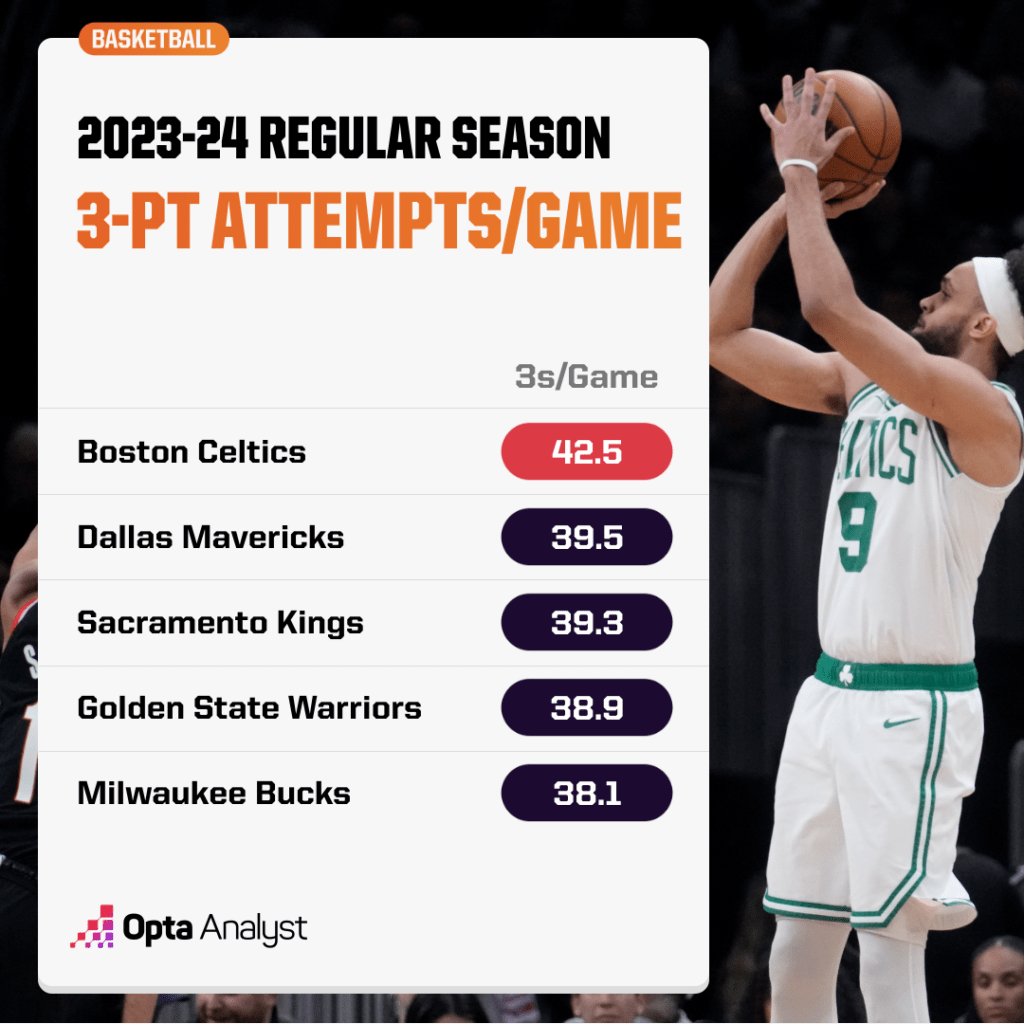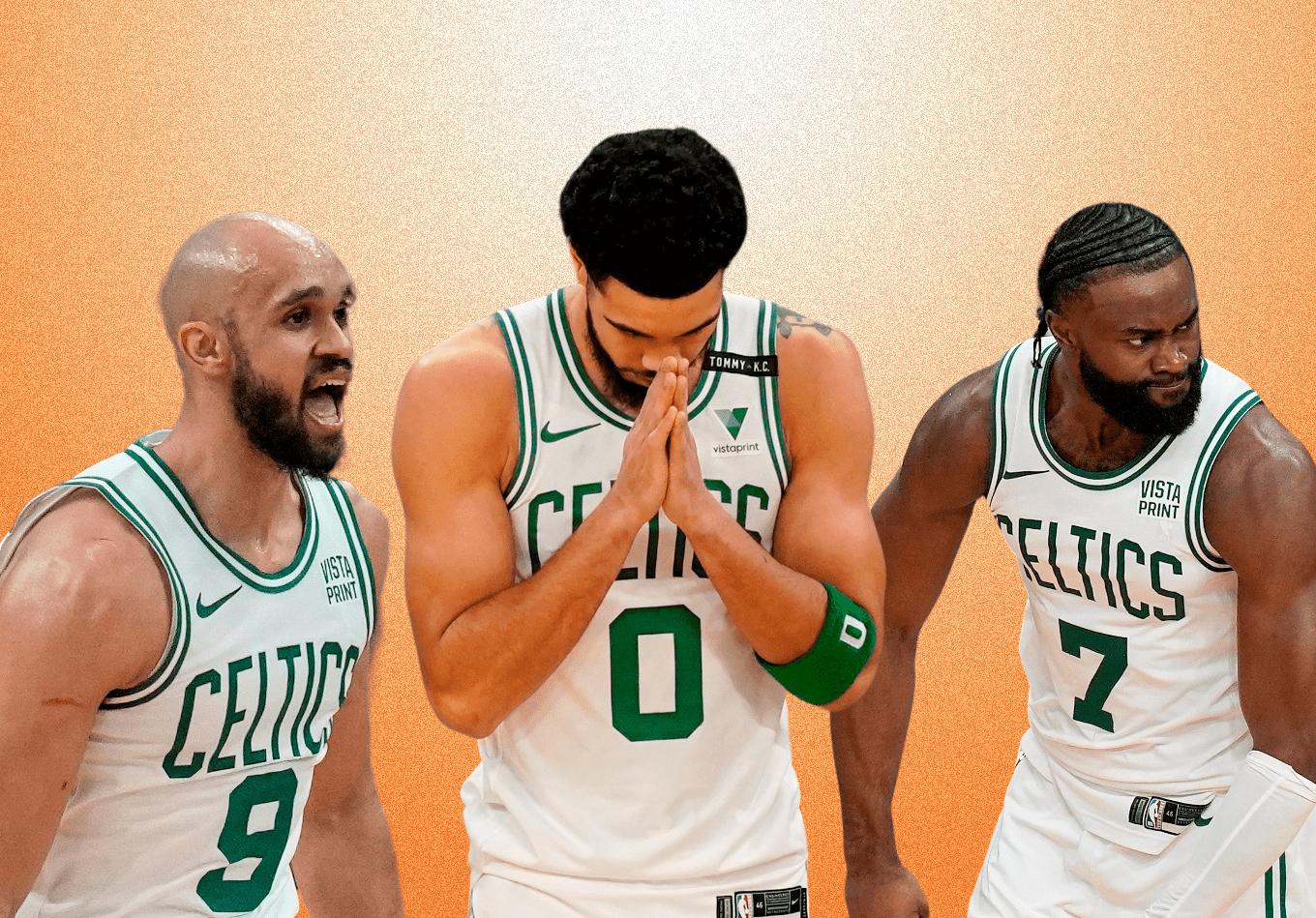The Boston Celtics finished the regular season with a league-best 64 wins. They stampeded through the first two rounds of the playoffs with an 8-2 record despite their arguably second-best player missing six of those games (and the first two of the conference finals).
And coming into their Eastern Conference finals series against the Indiana Pacers, our TRACR-powered supercomputer gave them an 81.5% chance of winning and a 65.2% probability of hoisting the Larry O’Brien Trophy in June (despite there still being four teams left in the dance).
So, Boston’s 2-0 lead in the conference finals after a Game 2 victory that was so convincing that it forced Pacers head coach Rick Carlisle to call in the troops early into the fourth quarter shouldn’t be that surprising. In fact, the Celtics have by far and away the most double-digit victories in the NBA since the start of the 2023-24 season.

And while the other 1 and 2 seeds have been eliminated, the East’s top seed keeps pushing through. Let’s look at the first two games of the East finals and explain how they’re doing it:
Too Big
A quick look at the Celtics and it’s not hard to discover how much size they employ. Jrue Holiday has a 6-foot-7 wingspan, Derrick White has a 6-7.5 wingspan, Jayson Tatum 6-11, Jaylen Brown 7-0 and Al Horford 7-1. That’s without even mentioning the 7-6 wingspan that they are missing with Kristaps Porzingis on the sideline.
Now, the Celtics don’t have a ton of girth (like a team like the Denver Nuggets or Los Angeles Lakers do), but that doesn’t matter because the Pacers don’t either.
The first thing Boston’s size advantage does is help win the offensive rebounding battle. Through two games, Boston has out offensive rebounded Indiana 26-22 and 83-81 overall. This postseason, the Celtics are 9-0 when they win the overall rebounding battle.
Boston’s size has also swung the turnover battle in its favor. During the regular season, the Celtics didn’t create a ton of turnovers (29th in opponent turnover percentage) – a byproduct of their conservative base defense. However, in this series, the Celtics are using their superior length to shrink driving and passing lanes and turn the Pacers over (the Pacers have 11 more turnovers than the Celtics so far).
Too Skilled
Along with the size advantage, the Celtics also have a massive skill advantage in this series.
DRIP has four Celtics in the top 50 and that’s not including Brown, who has killed the Pacers to a tune of 66 points on 51.1% shooting in the two games. White, Tatum and Porzingis (who could return by Game 4) are top-20 players in DRIP.
In the playoffs, teams make a concerted effort to poke at their opponent’s weaknesses. For the Pacers, that weakness comes in the form of their offensive supernova – Tyrese Haliburton. So, naturally, the Celtics’ strategy should be to target Haliburton when they are on offense.
But I’ve never seen a player get hunted as badly as Haliburton has been getting hunted in this series. According to NBA matchup data, the Celtics are 19 for 32 from the floor (59.4%) in this series on shots in which Haliburton is the primary defender. Here are a couple of those instances. Note: the upcoming footage may not be safe to view around children.
(Sidebar: Keep in mind that NBA matchup data does not factor in all the open shots created from the Pacers having to send extra help to assist Haliburton. An arguably more telling statistic is that Indiana’s defensive rating is 120.0 – worse than the worst team defensive rating this season – when Haliburton is on the court.)
To be fair to Haliburton, I also had the same thoughts about Tyler Herro when the Celtics were playing the Miami Heat and Darius Garland when the Cleveland Cavaliers were getting throttled by Boston in the conference semifinals.
The reason it looks so ruthless when the Celtics attack weak defenders compared to other teams is because of all the, you guessed it, skill they have on the court. For most teams, to hunt someone like Haliburton, they have to work to get him involved in an action with their primary/secondary offensive creator (kind of like the New York Knicks had to do with Jalen Brunson). Even if this strategy is successful, the approach bleeds precious seconds of the shot clock and risks bogging down an offense’s flow.
With the Celtics, they have so many players who can create off-the-dribble that they don’t need to go through that arduous process. They have the fast pass at Cedar Point. They can hunt Haliburton by just running the offense through the player the Pacers are trying to hide him on.
So far, the Pacers have tried stowing Haliburton away by giving him the Jrue Holiday matchup. In theory, that makes sense, considering he averaged only 12.5 points during the regular season. But in practice, the former two-time All-Star and 2021 NBA champ has rekindled his former glory and responded to the Pacers’ blatant disrespect by averaging 21.5 points and 9.0 assists on 86.8% true shooting in the first two games.
The absurdity of it all is that if the Pacers moved Haliburton onto White, the same phenomenon would likely take form. You best believe that would be the case if they tried testing his merit against Brown or Tatum. Hell, even Payton Pritchard would likely give Haliburton the business.
The Celtics’ breadth of skill is just too overwhelming.
Too Smart
The scariest part about the Celtics is that their brawn is matched (or maybe even exceeded) by their brain. Under head coach Joe Mazzulla (one of the best play-callers in the sport), the Celtics have fully embraced the 3-point revolution – launching more 3s than any team in the association.

The Celtics’ progressive shot diet is indicative of the team’s philosophy. They approach the game in an analytical manner, using an advanced understanding of tradeoffs to guide their decision-making.
One example is how they have changed their defensive matchups. To start the series, Horford was matched up against Myles Turner. This created problems for the Celtics when defending the Pacers’ signature Haliburton/Turner pick-and-roll. When Horford was in drop coverage, Haliburton could burn him with his trusty pull-up jumper (first clip in the montage below), and Turner could do damage as a roller or popper (second). And when Horford would switch pick-and-rolls, Haliburton would show the old man some new tricks (third).
So, the Celtics changed the matchups – having Brown or Tatum guard Turner and Horford guard Pascal Siakam. This change accomplished two things: First, it defanged the Haliburton/Turner pick-and-roll, since the Celtics could more seamlessly switch the action with their versatile wings/forwards (fourth). And it forced them to resort to more Haliburton/Siakam pick-and-rolls, which is less dangerous than Haliburton/Turner actions because Siakam (career 33% 3-point shooter) isn’t as good of a popper as Turner (35.4%).
(Sidebar No. 2: The reason the Celtics can pull this off is because Turner isn’t great at exploiting mismatches against smaller defenders in the post. So, the Celtics can get away with putting guys like Brown, Tatum, and even White on him.)
Now, this change in matchups did make life easier for Siakam. In Game 2, Siakam finished with 28 points on 13-for-17 shooting. But this is where the understanding of tradeoffs comes into play. The Celtics know that Siakam’s self-generated scoring isn’t enough to beat them on his lonesome (see the results of Game 2). So, they are willing to concede his eruption in the pursuit of a grander purpose (a series victory).
At the end of the day, the Celtics, who now have a 66.9% chance of winning their first title since 2008, are too big, too skilled and too smart for the valiant Pacers. That reality isn’t nearly as exhilarating as the thriller we were privileged to in last season’s Eastern Conference finals. But it is worthy of our respect and admiration, nonetheless.
And when you take a look at the data and film, this result should have been excepted anyway.
Check out our MLB, NBA and NFL coverage. Follow us on X and Instagram for more!
